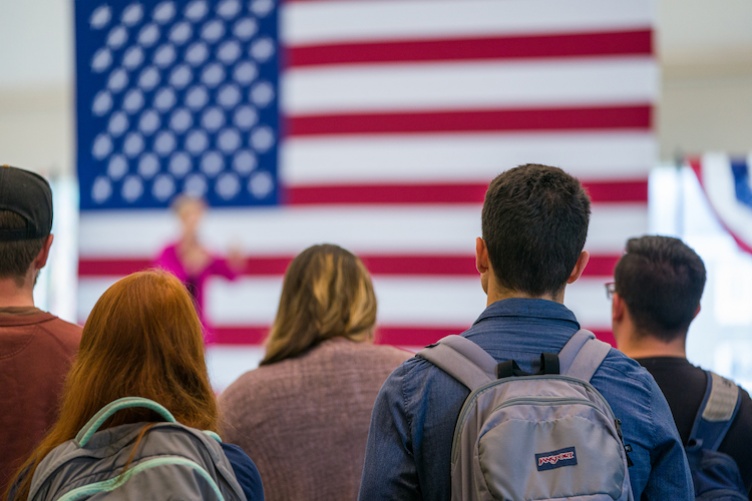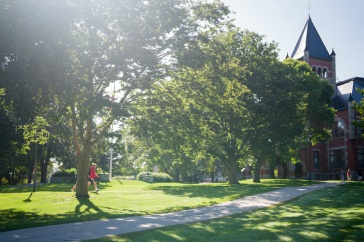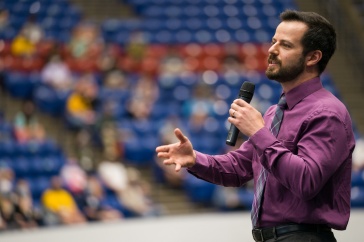
We’ve heard all the adjectives describing the 2020 election climate — challenging times; tumultuous times; unprecedented times; even, times of unprecedented challenges. And while there are unique issues surrounding this race — President Donald Trump testing positive for COVID-19 a month before voters go to the polls ranks as a never-before example — some of the concerns have already been witnessed in America’s voting history.
Threats of a revolt, for example, were made in 1860 when Southern states vowed to secede from the Union if Abraham Lincoln was elected. Voting by mail was utilized during the Civil War and then again during World War II. Concerns of voter intimidation began surfacing soon after Blacks gained the right to vote in 1870.
“We are certainly in uncharted waters,” says history professor Ellen Fitzpatrick. “We don’t know, of course, whether President Trump will become very sick from COVID-19 or have a mild response. But the election will go forward. Congress is empowered to set the date of the election under Article II of the U.S. Constitution; federal law stipulates it is held the first Tuesday after the first Monday in November. It would require a change in federal law to alter that date. Further, remember that many Americans have already voted or are voting each day by mail, so that the election is actually already in progress.”
“The problem we face this year is there are so many potential issues that could spark litigation. Parties will be suing each other and states over how ballots were counted; who should count them; changes in voting laws; questions about validity — people saying they voted, and their votes weren’t counted.”
The fact that so many Americans are opting to vote by mail has added to the heightened tensions and spawned worries about votes being counted, accuracy and voter fraud. And yet history has shown it works. “No-excuse absentee voting” is available in 34 states and the District of Columbia.
“Voting by mail is a safe, effective way to administer elections at the local and state level. Studies have found that the adoption of vote-by-mail decreases the costs of voting and increases turnout, which enhances the legitimacy of our elections,” says Emily Baer, assistant professor of political science. “The biggest issue is that election administrators are far more likely to reject these ballots. Voters may forget to sign the affidavit on their ballot, or their signature may not match the one on file at the DMV, which was part of the controversy in Georgia’s 2018 gubernatorial race outcome.”
Dante Scala agrees that such issues as confusion over how to fill out the ballot, the use of the secrecy sleeve (required in 16 states) and simply where to sign could lead to problems for first-time absentee ballot voters.
“Fraud is not my concern. For me it’s simple errors, human errors, without intent, that are more of a worry. When processes change abruptly there are bound to be some hiccups,” the political science professor says. “It’s just a matter of voters filling out the ballot by mail being more complicated. There are more steps to it so there is bound be a higher rate of error – which could mean votes. History shows it’s perfectly safe, but this year we’re putting a lot of strain on the system given how many states are allowing vote-by-mail for the first time.”
(Up until the pandemic, five U.S. states – Colorado, Hawaii, Oregon, Utah, and Washington —used a vote-by-mail system as a matter of practice. In May of this year, because of the coronavirus, Michigan enacted legislation to allow its residents to vote by mail for the presidential election.)
Director of the UNH Survey Center Andrew Smith suggests the massive number of mail-in ballots could potentially result in litigation. He referenced the divisiveness that has included Trump being asked if he would accept the election results should he lose the race.
“Win lose or draw, I think he would accept it. We’ve never had a sitting president not accept the results. If Trump loses, he’ll leave,” Smith says. “The problem we face this year is there are so many potential issues that could spark litigation. Parties will be suing each other and states over how ballots were counted; who should count them; changes in voting laws; questions about validity — people saying they voted, and their votes weren’t counted. I think there will be far more litigation than there was in 2000.”
On Trump’s comment about the election outcome, professor of history Jason Sokol says, “No president has ever declared before the election that he would not accept the voting results. There have been disputes after, however. Following the election of 1876, both candidates claimed to have won three southern states: South Carolina, Florida and Louisiana. In all three states, whites had attacked African-Americans (ex-slaves) who tried to vote. In South Carolina, whites even destroyed ballot boxes. In the end, a commission was formed to resolve the dispute. It handed those states, and the election to the Republican, Rutherford B. Hayes.”
And then there was the 2000 race between George W. Bush and Al Gore that had the state of Florida declaring Bush the winner by a margin of less that 0.5%, and the U.S. Supreme Court eventually supporting that assertion.
“Even in this case, when Vice President Gore had ample reason to challenge the decision, he acquiesced and accepted the court’s ruling,” Sokol says. “Throughout our history, there has been a tacit agreement that leading candidates would attempt to ensure peace even at the most trying moments.”
And that has been despite partisan polarization — the growing gap between liberals and conservatives, Republicans and Democrats — which, Scala says is a factor in the 2020 election.
“Partisan loyalty, party loyalty, tends to make elections closer than they used to be,” he says. “Voters tend to identify with a particular party’s ideology. There was a time when you would hear people say they were a conservative Democrat or a liberal Republication; there was a lot more diversity in both parties. Nowadays, voters have sorted themselves out. If you’re a conservative, it’s pretty clear what your choice is; if you’re liberal, it’s pretty clear. It almost doesn’t matter who the candidate is. You vote how you see yourself. Our personal identity is tied up with our political identity— and personal identity is lot to leave behind.”
-
Written By:
Jody Record ’95 | Communications and Public Affairs | jody.record@unh.edu



















































